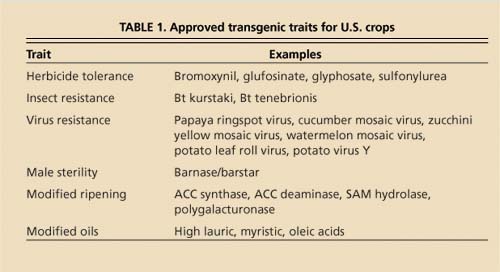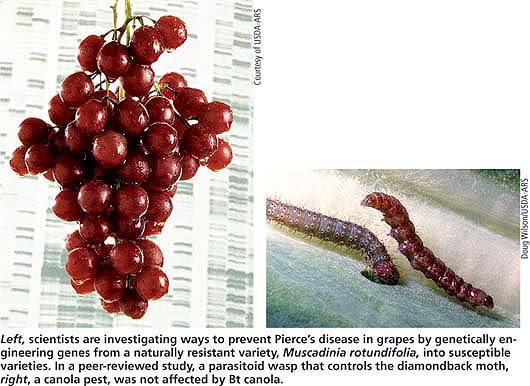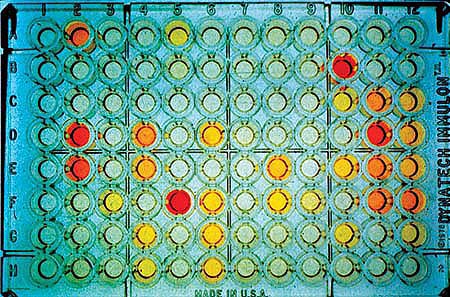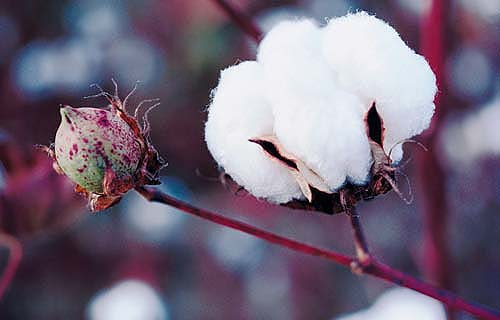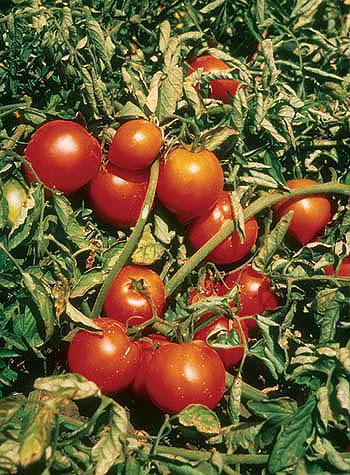All Issues
Despite benefits, commercialization of transgenic horticultural crops lags
Publication Information
California Agriculture 58(2):89-98. https://doi.org/10.3733/ca.v058n02p89
Published April 01, 2004
PDF | Citation | Permissions
Abstract
The acreage of agronomic crops (soybean, cotton, corn and canola) developed using recombinant DNA technology has expanded dramatically since their introduction in 1996, while the commercialization of biotech horticultural crops (vegetables, fruits, nuts and ornamentals) has languished. This is not due to a lack of both current and potential traits that could be utilized in horticultural crops, as ongoing research is identifying a diverse array of applications. However, commercialization is stalled by market reluctance to accept biotech products, particularly in the absence of clear benefits to consumers. High regulatory costs and restricted access to intellectual property create additional hurdles for specialty crops. These challenges are causing the horticultural industry to forego a number of current benefits. New products with clear advantages for producers, marketers and consumers may be required before the potential of biotechnology can be realized.
Full text
IN 2003, nearly 106 million acres of transgenic or genetically engineered (GE) crops was planted in the United States, part of 167 million acres of such crops grown worldwide (James 2003). Despite the fact that the first commercialized transgenic food crop was the Flavr Savr tomato, four agronomic crops (corn, soy, cotton and canola) account for virtually all of the current acreage. Last year, only four horticultural crops developed using recombinant DNA technology were available in the United States: papaya, sweet corn, squash and a carnation. Except for transgenic papaya, which accounts for approximately 50% of the Hawaiian crop (HASS 2001), the fraction of the total horticultural commodities represented by transgenic varieties is miniscule.
The absence of significant commercialization of transgenic varieties in horticulture is not due to lack of potential products or value (Dandekar and Gutterson 2000; see sidebar, page 94 ). The basic techniques of molecular biology have become routine, and considerable research is being conducted on horticultural crops. For example, herbicide resistance has been transferred into bentgrass and bluegrass to make weed control in municipal and highly managed turf environments such as golf courses more efficient. However, they have not been commercialized. Similarly, some horticultural crops, including lettuce and tomato, have been engineered with herbicide resistance and tested in field trials but remain uncommercialized. Disease resistance, particularly to viruses, can be developed using biotechnology, and potato and papaya cultivars engineered for virus resistance have been commercialized, but many potential applications are currently underutilized. Improving traits that directly benefit consumers, such as nutritional or aesthetic quality, is also technically feasible now in many horticultural crops, but only a few products have reached the market.
Florigene, of Melbourne, Australia, markets transgenic carnations engineered for blue-violet color under the variety name ‘Moonshadow’.
Approved traits and technologies
The major technologies that have been approved and widely adopted by the industry focus on input traits, or those affecting production of the crop rather than the qualities of the final product. Although most approved genes confer insect resistance and herbicide tolerance, a range of genetic traits has been approved by the U.S. regulatory system (table 1).
Insect resistance.
Insect resistance has been engineered primarily by using two classes of bacterial genes derived from Bacillus thuringiensis(Bt) ssp. kurstaki and ssp. tenebrionis (de Maagd et al. 2003). These Bt genes control a broad spectrum of lepidopteran and coleopteran insects, respectively. The genes have been approved for use in major row crops (feed corn and cotton) and some horticultural crops (sweet corn and potato). Potato and sweet corn varieties engineered for resistance to Colorado potato beetle and corn earworm, respectively, were in commercial production for several years and were technically and agronomically successful, allowing significant reductions in insecticide use (Shelton et al. 2002). However, the transgenic potato varieties were withdrawn from the market after major processors and distributors chose not to purchase and market them. Bt sweet corn, while still available, is not widely grown for the same reason (Cornell Cooperative Extension 2003).
Herbicide tolerance.
Several herbicide-tolerance genes are registered for use. The most widely commercialized gene is a bacterial enzyme conferring tolerance to glyphosate, the active ingredient of Roundup herbicide. Transgenes conferring tolerance to bromoxynil (Buctril), glufosinate (Liberty) and sulfonylurea (Glean) herbicides are also approved for use in a wide variety of crops. In addition, crops tolerant to imidizolinone (Clearfield) and sulfonylurea herbicides have been developed through nontransgenic methods based on natural or induced mutations. However, no horticultural crops engineered for herbicide resistance have been commercialized, although several have been developed and tested.
Virus resistance.
The use of viral coat protein genes to confer resistance has been approved for several viruscrop combinations (table 1). The most commercially successful has been papayas engineered for resistance to the papaya ringspot virus. This product has revived the Hawaiian papaya industry, which was devastated by the virus in the 1990s ( see sidebar, page 92 ). Small acreages of transgenic squash resistant to mosaic viruses are also grown. Virus-resistant potato varieties were formerly commercialized but are not currently being marketed. Newer technologies, such as RNA interference or RNA silencing (Waterhouse et al. 2001), offer promise for developing resistance to other damaging diseases, such as those caused by geminiviruses (Gilbertson et al. 1998).
Left, scientists are investigating ways to prevent Pierce's disease in grapes by genetically engineering genes from a naturally resistant variety, Muscadinia rotundifolia, into susceptible varieties. In a peer-reviewed study, a parasitoid wasp that controls the diamondback moth, right, a canola pest, was not affected by Bt canola.
Flavr Savr tomato.
Transgenic horticultural crops providing direct benefits to the consumer have also been developed. Calgene's Flavr Savr tomato silenced the gene encoding polygalacturonase, an enzyme implicated in fruit softening. The expectation was that the tomato would soften and spoil more slowly and could be picked at a later stage of maturity. This later harvest, in principle, would permit greater development of flavor compounds and better taste. This product, first marketed in 1994, was a success with consumers but failed economically for a variety of reasons (Martineau 2001). This same gene was also used in a tomato variety processed for paste and marketed by Zeneca in the United Kingdom. The trait reduced processing costs and consumers accepted the clearly labeled product, until the European uproar over biotech foods forced it off the supermarket shelves.
U.S. regulatory agencies also approved several other delayed-ripening tomato varieties based on strategies targeted to block the ethylene biosynthetic pathway (ACC deaminase and antisense / cosuppressed ACC synthase) that is essential for ripening. None of these products is currently marketed, despite their technical feasibility and potential consumer benefits. Rather, they were preempted by a nonbiotech approach utilizing the naturally occurring rinmutant of tomato that delays fruit ripening. Heterozygous plants produce fruits that ripen at a significantly slower rate than normal fruits. A nontransgenic approach achieved essentially the same objective, and aggressive breeding and marketing of the long-shelf-life rin hybrid tomatoes made the transgenic approach redundant.
Lengthening postharvest time.
Similarly, virtually all bananas marketed in the United States are naturally deficient in their ability to initiate ethylene synthesis, allowing them to be shipped green and ripened by exposure to ethylene gas prior to sale. However, where natural mutants are not available, the general approach of manipulating ethylene synthesis has great potential for application in other climacteric fruits (whose ripening is mediated by ethylene), particularly tropical fruits with short postharvest lives such as mango, papaya and banana. A higher quality fruit bringing tangible value to the consumer could improve the market acceptance of biotech crops.
Despite their early introduction and initial market success, and in contrast to what many consumers may believe, the only biotech horticultural commodities currently marketed in the United States are Hawaiian papayas, a small amount of squash and sweet corn, and a few carnation varieties. The commonly cited estimate that as much as 70% of food products in U.S. supermarkets contain ingredients from GE crops is not attributable to fruits and vegetables, but rather to the widespread use of corn, canola and soybean oil, soybean protein, corn starch and related products in virtually all processed foods.
Opportunities for biotechnology
As global acreage of biotech agronomic crops sustains its eighth consecutive year of double-digit growth rates (increasing 15% from 2002 to 2003) (James 2003), it is paradoxical that the trend in horticultural crops is exactly the opposite, particularly as many of the approved genes fit naturally with the needs of horticultural crops. Fear of consumer rejection on the part of both producers and marketers of horticultural products is a major impediment to wider utilization of biotechnology, even though many consumer polls do not find a majority negative opinion about it ( see page 99 ). Many food companies are unwilling to risk the consequences of alienating even a small fraction of their potential market (Gillis 2000). Clearly, growers, distributors and consumers must all see biotech crops as in their best interests for commercialization to be successful. Products offering compelling value could alter the economic forces influencing producer choices and could create consumer demand to pull such products through the marketplace.
Loss of pesticides.
One factor that may significantly alter grower economics is the loss of currently registered pesticides due to environmental and health concerns. For example, methyl bromide is scheduled to be withdrawn from use in the United States in 2005 because it contributes to depletion of the ozone layer. Methyl bromide is widely used in horticultural crops to control soilborne diseases and weeds and to fumigate harvested crops to eliminate insects. The majority of this use is in horticultural crops (primarily strawberries, tomatoes, peppers, ornamentals and nurseries, and tree crops) with California and Florida together accounting for 80% of the 35 million pounds applied each year for preplant fumigation (Economic Research Service 2000). Many genes are available that potentially could be used to enable alternative weed-control strategies.
Horticultural crops are also limited in the numbers of herbicides registered for use. Loss of registration for a few key chemicals could markedly limit grower options, making crop resistance to broad-spectrum herbicides more critical. Resistance to fungal and bacterial diseases would also be desirable, as in some areas extensive use of pesticides is currently undertaken for their control. As for herbicides, it is also difficult to maintain registrations for minor crops grown on smaller acreages, which are primarily horticultural. Biotech strategies are being developed that could provide broader spectrum disease control and reduced dependence upon chemical pesticides (Lincoln et al. 2002). Resistance to viral diseases would be valuable in many horticultural crops, as there are few other options for control, and methods for engineering virus resistance are well established.
Biotechnology is contributing to the development of sensitive diagnostic techniques. Above,plant samples are placed in wells and subjected to a color-based detection system; yellow shows evidence of disease.
Tree fruit, nuts and grapes.
Research is well under-way to build a robust platform of technologies to utilize genomics in the discovery of useful traits for trees (Dandekar et al. 2002). Transformation technology has been developed and trait evaluation is under way on apple, almond, peach, citrus, walnut, pear, plum, grapevine and persimmon. Good progress has been made in developing resistance to codling moth and fireblight in apple, plum pox virus in plum/Prunus, crown gall and codling moth in walnut, citrus tristeza virus (CTV) in citrus and Pierce's disease in grapevine.
Engineering of resistance to codling moth in apple to reduce the use of chemical pesticides has advanced to the point of commercial interest in product development. Work is also under way to develop productivity and quality traits such as modified sugar metabolism and ripening in apple and regulation of self-incompatibility in almond and other Prunus species. Some deployment strategies for transgenic trees are also being developed, such as the use of transgenic trees as “trap crops” to control insects in conventional orchards and the use of transgenic rootstocks to control diseases and pests in nontransgenic scion varieties ( see sidebar, page 96 ). The latter approach avoids the task of transforming many varieties of a particular tree crop and in the future may be used to regulate quality and productivity traits.
Nutrients, consumer qualities.
Although more difficult technically and therefore not close to market, there are many potential opportunities for enhancing the nutritional value or consumer appeal of horticultural products through biotechnology. In addition to modification of ripening, projects to increase the content of vitamins, minerals or nutraceuticals in horticultural products are in progress (Grusak and Della Penna 1999). The development of Golden Rice with enhanced betacarotene (pro-vitamin A) in the grain (Ye et al. 2000) demonstrated the potential for biotechnology to increase nutritional value. Whether such products will have sufficient consumer appeal in fully developed markets to drive their commercialization remains to be seen.
Floriculture, ornamental plants
Since floricultural and ornamental plants are grown for aesthetic or other nonedible purposes, there may be less potential for public concern about GE varieties than there has been with biotech food crops.
Flower color.
Several ornamental plants, including carnation, rose and gerbera, have been engineered for modified flower color. Research has focused on the manipulation of either anthocyanins (red and blue colors) or carotenoids (yellow and orange colors), with the intent of creating a wider range of flower colors than occurs naturally, as well as to produce natural dyes for industrial purposes (Lu et al. 2003). Florigene is selling Transgenic Moon series carnations engineered for dark violet-purple color around the world. The varieties are developed in Australia and flowers are produced primarily in South America for marketing in the United States and Japan.
Floral scent.
Putting the scent back into flowers that have “lost” this trait over years of traditional hybridization and selection, or creating new fragrances in plants, has considerable potential and appeal. Research on genes controlling the different biochemical pathways for various floral fragrances is being conducted on wild plants and on crops such as snapdragon, petunia and rose (Vainstein et al. 2001).
Plant size.
Currently, growth-regulating chemicals are applied to ornamental plants to inhibit gibberellic acid (GA) synthesis and reduce plant height during crop production. Many newly introduced ornamental species are receiving particular attention via conventional breeding for dwarf plants because their natural habits do not fit into marketing systems requiring compact plants. The manipulation of GA metabolism via biotechnology has the potential to produce ornamental and flowering plants with reduced-height phenotypes (Clark et al. 2003). The development of lawn grasses that require significantly less frequent mowing is another obvious application. Early experiments suggest that expression of genes controlling height can be applied to many plant species.
Leaf life.
Engineering of plants to delay leaf senescence (yellowing) is also being pursued in ornamental crops. For years, ornamental breeders have selected new cultivars of plants with more attractive “stay green” phenotypes. Cytokinins are plant hormones well known to delay the loss of chlorophyll in leaves; using biotechnology, targeted expression of genes involved in cytokinin synthesis is now possible. When a gene promoting cytokinin biosynthesis is inserted into plants in conjunction with a regulator (promoter) that turns the gene on only when the leaf starts to senesce, leaf life is extended in transgenic plants exposed to drought, nutrition and pathogen stress (Gan and Amasino 1995; Clark et al. 2004).
Ethylene sensitivity.
As in fruit ripening, manipulation of ethylene synthesis or sensitivity has applications in the ornamental plant industry. Ethylene accelerates floral and foliar senescence, and chemical methods have been developed to mitigate its effects (Sisler and Serek 2003). Ethylene sensitivity can be reduced in floriculture crops through applications of the ethylene antagonist silver thiosulfate (STS), but unfavorable environmental aspects such as metal contamination of groundwater restrict its commercial use. Another compound, 1-methylcyclopropene, also blocks the ethylene receptor protein and makes plant tissues insensitive to ethylene, delaying ripening or senescence. Although this compound is effective in many crops, its action decreases with time after treatment as the tissues synthesize new ethylene receptor proteins during postharvest transit. By expressing a mutant form of the ethylene receptor protein or by blocking expression of components of the ethylene-signaling pathway, petunia plants with longer lasting floral displays have been produced (Wilkinson et al. 1997). Unfortunately, negative side effects, such as higher susceptibility to fungal pathogens and decreased rooting of vegetative cuttings, have limited the commercial use of these technologies. The key to effective manipulation of ethylene sensitivity will be the use of promoters limiting transgene expression to the target tissue, leading ultimately to plants that have longer lasting flowers with no negative side effects.
Cotton has been genetically engineered to express a protein from a naturally occurring bacterium. Bacillus thuringiensis, which is toxic to insect pests such as bollworm and budworm. This cotton is widely planted in California and elsewhere in the United States.
Hurdles to commercialization
The lag in commercialization of transgenic horticultural crops clearly is not due to a lack of useful genes or valuable applications. However, several fundamental issues inherent to horticultural crops create significant hurdles ( see sidebar, page 84 ).
Biological diversity.
Simply the diversity of crops utilized in horticulture slows the adoption of new technologies. For any given crop, there may be several different species and dozens of cultivars that are currently marketed, and the turnover of new cultivars from year to year is tremendous. For example, as many as 60 distinct cultivars of iceberg lettuce alone may be grown throughout the year as production locations shift seasonally. Add to this the dozens of additional varieties for romaine, leafy, red and other specialty types, and it is evident that introducing a new biotech trait for lettuce requires developing not just one but many new varieties. In perennials such as trees and vines, on the other hand, the choice of a variety is a long-term commitment, making growers cautious in selecting novel varieties.
Market acceptance.
Currently, the largest impediment to adoption of at least some biotech horticultural products is the lack of market acceptance. Biotech products having documented agronomic, economic and environmental advantages have been removed from the market due to the concerns of processors and distributors about potential consumer rejection.
Intellectual property.
Large corporations focused on the major agronomic crops own the majority of patents on the genes and enabling technologies (such as transformation protocols and promoters) required for genetically engineering plants. They are generally not interested in the smaller horticultural markets, and may not want to license their technologies, depending on the impact it could have on their other approved crops ( see page 120 ).
Post-commercialization.
Post-commercialization stewardship is also an increasingly important consideration to technology owners in deciding whether to license their intellectual property. In Bt crops, for example, insect-resistance management programs must be developed and monitored after commercialization. Identity preservation programs and segregation of products in the distribution channels may be required when marketing in locations where they are not approved. Herbicide applications to diverse horticultural crops have the potential to increase the Average Daily Intake (ADI) over the maximum permitted level for the pesticide active ingredient. (ADI is the total residues of a pesticide that a consumer can be exposed to, considering all sources; the government sets limits for each pesticide.) An agrochemical company will not approve the use of its herbicide-resistance trait in a small acreage crop if it endangers the registration of that herbicide for millions of acres of field crops.
“Golden Rice” has been genetically engineered to produce beta-carotene, the precursor to vitamin A. However, for a variety of reasons it is not yet available to farmers in developing countries, where vitamin A deficiencies are common.
Regulatory requirements.
Extensive safety testing is required for regulatory approval (deregulation) of biotech crops beyond what is required for varieties bred using traditional methods ( see page 106 ). If the trait has already been approved in other crops, the costs are lower as prior data can be used to support an application. However, for novel traits likely to be of interest for horticultural crops, the costs could be millions of dollars. For example, by some estimates it will cost $20 million to achieve deregulation of Golden Rice for humanitarian purposes in six developing countries (I. Potrykus, UC Davis seminar, Jan. 22, 2003). Since each transgenic event (each insertion of a gene in a genome) must be separately tested and approved, it is not feasible to transform multiple varieties with a given trait to amortize the research and technology investment across a given crop. Instead, a single insertion event is approved for commercialization and then must be transferred via standard backcrossing to other varieties. This is highly inefficient and often makes it difficult to regain the unique properties of all the diverse varieties. Public-private partnerships are one way to reduce the costs of commercialization ( see page 116 ). The IR-4 program could also assist with chemical residue testing and with other aspects of meeting the regulatory requirements for release of transgenic horticultural crops ( see sidebar, page 110 ).
The first transgenic crop to receive U.S. government approval was a tomato engineered to soften more slowly than conventional tomatoes, allowing it to be picked later for improved flavor and taste. Bioengineered horticultural crops with clear benefits to consumers may be needed to overcome market reluctance. Above, conventional tomatoes.
Compelling benefits key
The commercial applications of biotechnology to horticultural crops lag far behind those of agronomic crops. In some respects this is to be expected, since the majority of research and investment has been directed to commodities with the greatest commercial value. For consumer and quality traits, however, many of the most interesting applications will be in horticultural crops. Intellectual-property issues must be resolved and regulatory costs reduced before significant progress can be made toward commercialization of transgenic products. However, the major impediment to horticultural biotechnology is the reluctance of the market to accept and actively promote these products. The development of products having compelling benefits for producers, marketers and consumers may be required to overcome this situation.




